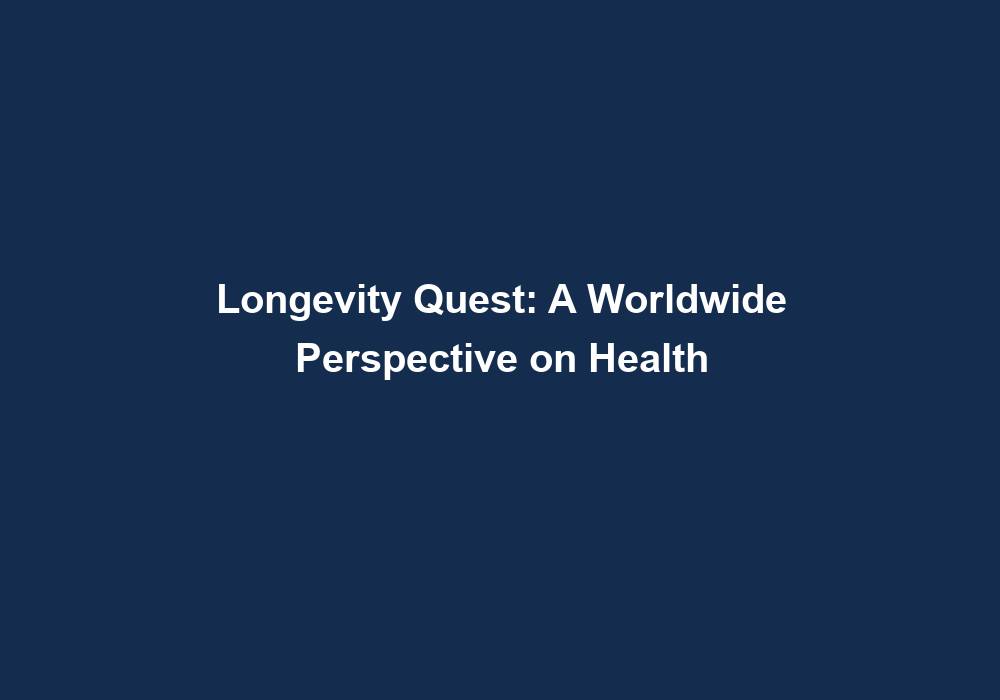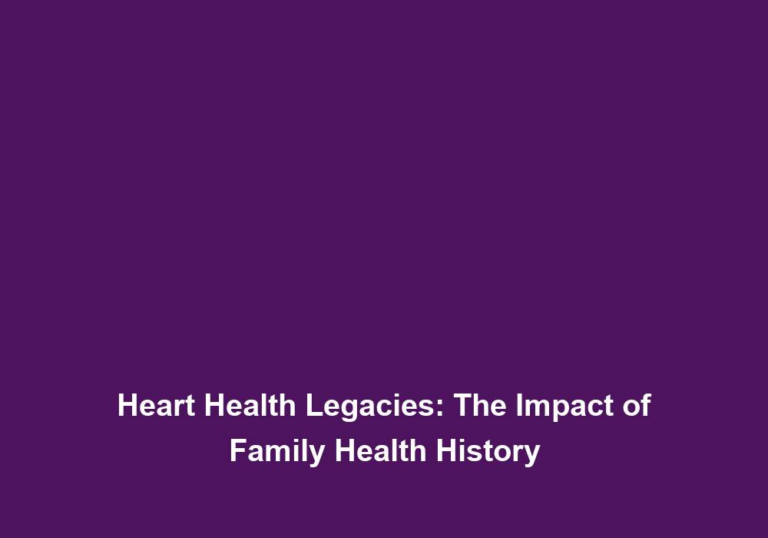Longevity Quest: A Worldwide Perspective on Health
In today’s fast-paced world, the quest for longevity has become a universal pursuit. People from all corners of the globe are seeking ways to lead healthier, longer lives. With advancements in technology, medicine, and scientific research, we now have a deeper understanding of what factors contribute to longevity and how different cultures approach health. This article will take you on a captivating journey, exploring the worldwide perspective on health and longevity.
The Blue Zones: Unlocking the Secrets of Longevity
One fascinating aspect of the worldwide quest for longevity is the exploration of Blue Zones. These are regions around the world where people seem to live exceptionally long and healthy lives. Researchers have delved into these areas, uncovering common lifestyle and cultural factors that contribute to their residents’ longevity.
1. Okinawa, Japan
Okinawa, Japan, is one such Blue Zone that has captured the world’s attention. The Okinawan people have one of the highest life expectancies globally, with a significant number of centenarians. Their longevity is attributed to a combination of genetic factors and a traditional diet rich in vegetables, fish, and tofu. The Okinawan lifestyle also emphasizes daily physical activity, social connections, and a sense of purpose, all of which contribute to their exceptional health.
The Okinawan diet is centered around nutrient-dense plant-based foods, such as sweet potatoes, seaweed, and bitter melon, which are packed with essential vitamins, minerals, and antioxidants. Fish, particularly fatty fish like salmon, provides omega-3 fatty acids that support heart health and reduce inflammation. Tofu, a staple in Okinawan cuisine, is a source of lean protein and is associated with a lower risk of heart disease.
In addition to their diet, the Okinawans engage in regular physical activity, such as gardening, walking, and practicing martial arts like tai chi. These activities not only promote cardiovascular health but also contribute to overall strength, balance, and flexibility. Social connections play a vital role in Okinawan culture, as the community values strong relationships and support networks. This sense of belonging and purpose contributes to reduced stress levels and enhanced mental well-being.
2. Sardinia, Italy
Sardinia, a Mediterranean island in Italy, is another Blue Zone famed for its longevity. The Sardinian diet, which primarily consists of whole grains, legumes, fruits, and vegetables, along with moderate consumption of red wine, has been linked to lower rates of heart disease and other age-related illnesses. Additionally, the strong sense of community and family bonds in Sardinian culture promotes mental well-being and longevity.
The Sardinian diet is rich in plant-based foods, providing a wide range of vitamins, minerals, and dietary fiber. Whole grains like barley and fregola are commonly consumed and contribute to a reduced risk of chronic diseases such as heart disease and diabetes. Legumes, including beans and lentils, are high in protein, fiber, and antioxidants, offering numerous health benefits. The moderate consumption of red wine, particularly Cannonau wine, which is rich in antioxidants, is believed to have a protective effect on the cardiovascular system.
Beyond their diet, Sardinians place a strong emphasis on family and community. Social connections and support networks are deeply ingrained in their culture, providing a sense of belonging and emotional well-being. Regular social interactions and engagement in community activities contribute to reduced stress levels and a higher quality of life.
3. Nicoya Peninsula, Costa Rica
The Nicoya Peninsula in Costa Rica holds the secrets to the longevity of its inhabitants. The traditional diet of the Nicoyans includes fresh fruits, vegetables, beans, and corn. Regular physical activity, close-knit communities, and a positive outlook on life are also significant contributors to their long and healthy lives.
The Nicoyan diet is predominantly plant-based, with an abundance of tropical fruits and vegetables. These colorful foods provide a wide range of vitamins, minerals, and antioxidants that support overall health and well-being. Beans and corn, staple foods in the Nicoyan diet, are excellent sources of plant-based protein, fiber, and essential nutrients.
Physical activity is an integral part of daily life in the Nicoya Peninsula. The residents engage in activities such as farming, walking, and dancing, which not only contribute to physical fitness but also promote a strong sense of community. The close-knit communities in Nicoya provide social support, encouragement, and a sense of belonging, all of which are vital for mental and emotional well-being.
4. Ikaria, Greece
Ikaria, a small Greek island, has gained attention as a Blue Zone due to its remarkable number of centenarians. The Ikarian diet, rich in vegetables, whole grains, olive oil, and herbal teas, along with an active lifestyle that includes daily walks and gardening, plays a crucial role in their longevity. The strong sense of community and social connections also contribute to their overall well-being.
The Ikarian diet focuses on fresh, locally sourced ingredients that are minimally processed. Vegetables, including dark leafy greens, tomatoes, and eggplants, are consumed in abundance and provide a wide array of vitamins, minerals, and antioxidants. Whole grains such as bulgur, barley, and whole wheat bread are rich in fiber and contribute to a healthy digestive system. Olive oil, a staple in the Mediterranean diet, is a source of monounsaturated fats that promote heart health. Herbal teas, often made from locally grown herbs like sage and chamomile, offer various health benefits and are a part of the Ikarian daily routine.
Apart from their diet, Ikarians lead active lifestyles that incorporate daily physical activity. Walking is a common form of exercise, and gardening is a popular activity that not only provides fresh produce but also promotes physical fitness and mental well-being. The strong sense of community in Ikaria fosters social connections and support networks, reducing stress levels and enhancing overall happiness.
5. Loma Linda, California, USA
Loma Linda, California, stands out as a unique Blue Zone, given its location in the United States. The community of Seventh-day Adventists residing in Loma Linda has significantly longer life expectancies compared to the general American population. Their vegetarian diet, regular exercise, strong religious beliefs, and supportive social networks all intertwine to create an environment conducive to longevity.
The Loma Linda community follows a vegetarian diet, which is primarily plant-based and excludes meat, poultry, and fish. This diet is rich in fruits, vegetables, legumes, whole grains, nuts, and seeds, providing a wide range of nutrients and health benefits. The emphasis on plant-based proteins such as beans and lentils ensures an adequate intake of essential amino acids while reducing the risk of chronic diseases.
Regular exercise is a fundamental aspect of the Loma Linda lifestyle. The community engages in physical activities such as walking, hiking, and cycling, which not only promote cardiovascular health but also contribute to overall fitness and well-being. Strong religious beliefs and a sense of purpose play a significant role in the lives of the Seventh-day Adventists, providing a source of motivation, resilience, and inner peace. The supportive social networks within the community foster a sense of belonging and emotional well-being.
Cultural Approaches to Health and Longevity
While the Blue Zones offer valuable insights, it’s important to recognize that health and longevity vary across different cultures worldwide. Each culture brings its own unique practices and perspectives on well-being. Let’s explore some fascinating cultural approaches to health and longevity:
1. Traditional Chinese Medicine
Traditional Chinese Medicine (TCM) has been practiced for thousands of years and emphasizes the balance of yin and yang energies within the body. TCM incorporates holistic treatments such as acupuncture, herbal medicine, and tai chi to promote overall health and longevity. The emphasis on preventive care and the body’s natural healing abilities sets TCM apart as a unique approach to well-being.
In TCM, the concept of yin and yang represents the balance and harmony of opposing forces within the body. Acupuncture, a key component of TCM, involves the insertion of thin needles into specific points on the body to stimulate the flow of qi (vital energy) and restore balance. Herbal medicine, another integral part of TCM, utilizes a combination of medicinal plants, minerals, and animal products to address imbalances and support the body’s natural healing process. Tai chi, a gentle form of exercise, promotes physical fitness, balance, and relaxation, contributing to overall well-being.
2. Ayurveda in India
Originating in ancient India, Ayurveda is a holistic healing system that focuses on maintaining balance between mind, body, and spirit. Through personalized dietary plans, yoga, meditation, and herbal remedies, Ayurveda aims to prevent disease and promote longevity. Ayurvedic principles are deeply ingrained in Indian culture and have gained recognition worldwide for their holistic approach to health.
Ayurveda views each individual as unique, with a specific mind-body constitution known as doshas (Vata, Pitta, and Kapha). A balanced diet, tailored to an individual’s dosha, is recommended to maintain optimal health. This diet typically includes a variety of whole foods, herbs, and spices that support digestion, metabolism, and overall well-being. Yoga and meditation are integral parts of Ayurveda, promoting physical strength, flexibility, mental clarity, and emotional balance. Herbal remedies, derived from plants and minerals, are used to address specific health concerns and restore balance within the body.
3. Nordic Lifestyle
The Nordic countries, including Denmark, Sweden, Norway, Iceland, and Finland, consistently rank among the healthiest nations globally. Their lifestyle is characterized by a strong emphasis on outdoor activities, physical fitness, and a diet rich in fish, whole grains, berries, and vegetables. The Nordic approach to health intertwines social equality, access to nature, and a balanced work-life culture to promote longevity and well-being.
The Nordic diet emphasizes locally sourced, seasonal, and sustainable foods. Fish, particularly fatty fish like salmon, herring, and mackerel, are rich in omega-3 fatty acids that support heart health and brain function. Whole grains, such as rye and oats, provide dietary fiber and promote satiety. Berries, such as lingonberries and blueberries, are packed with antioxidants and contribute to overall health. Vegetables, especially root vegetables and cruciferous vegetables, offer a wide range of vitamins, minerals, and antioxidants.
Outdoor activities are an integral part of the Nordic lifestyle. The residents actively engage in activities such as hiking, cycling, skiing, and swimming, taking advantage of the region’s natural beauty and access to nature. Regular physical activity not only promotes physical fitness but also enhances mental well-being and reduces stress levels. The Nordic culture emphasizes social equality, providing equal opportunities for education, healthcare, and a balanced work-life culture, which contributes to overall happiness and well-being.
4. Indigenous Wisdom
Indigenous cultures worldwide possess invaluable wisdom when it comes to health and longevity. Their deep connection to nature, traditional healing practices, and a harmonious relationship with the environment set them apart. From the Aboriginal people of Australia to Native American tribes, indigenous communities often prioritize holistic well-being, communal support, and spiritual connectedness as foundations for a long and fulfilling life.
Indigenous cultures place great importance on the interconnectedness of all living beings and the environment. Their traditional healing practices often involve the use of medicinal plants, rituals, and ceremonies to restore balance and harmony within the body and the community. The deep connection to nature encourages physical activity, as many traditional practices involve hunting, fishing, gathering, and farming. Communal support and social connections are integral to indigenous cultures, providing a sense of belonging, emotional support, and shared wisdom. Spiritual connectedness, often through ceremonies and rituals, nurtures inner peace, resilience, and a sense of purpose.
The Path to Longevity: Universal Principles
While cultural approaches to health and longevity may differ, certain universal principles underpin the quest for a longer and healthier life. Regardless of cultural background, incorporating these principles can help individuals worldwide on their longevity journey:
- Balanced Diet: Emphasize whole foods, fruits, vegetables, and lean proteins while minimizing processed foods and sugary beverages. Include a variety of nutrients to support overall health and well-being.
- Regular Physical Activity: Engage in moderate-intensity exercise for at least 150 minutes per week. Find activities you enjoy to make it a sustainable lifestyle change. Exercise promotes cardiovascular health, strength, flexibility, and mental well-being







